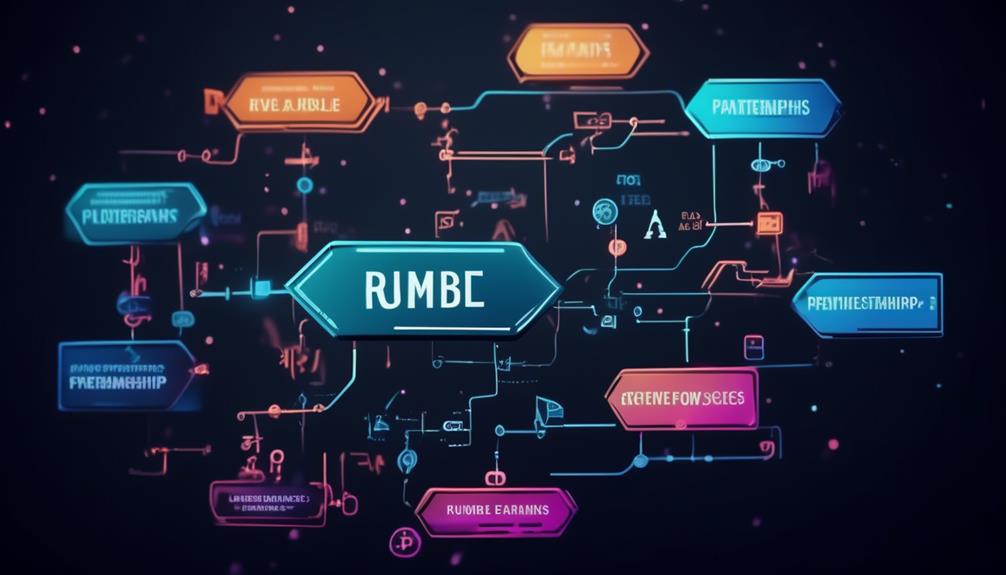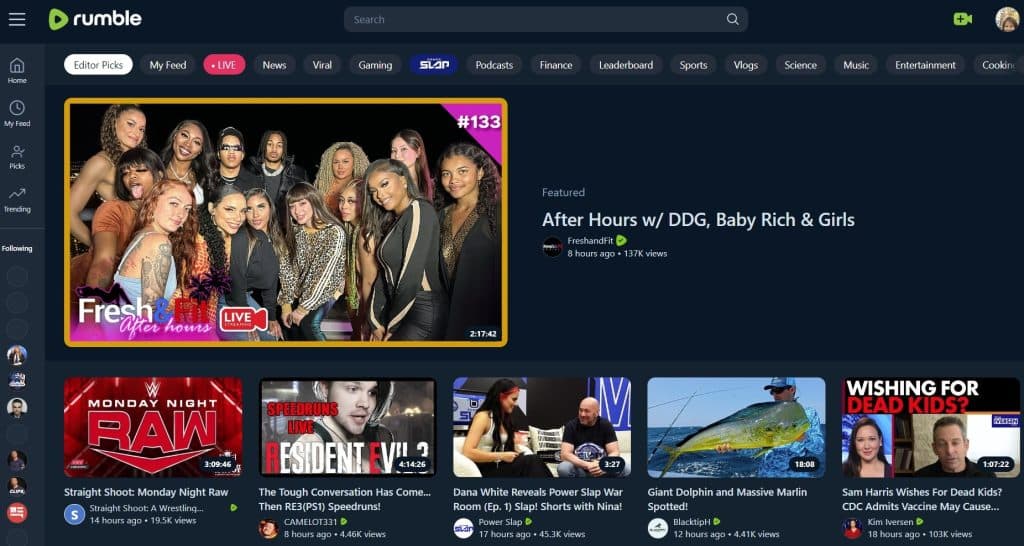Rumble is an emerging video-sharing platform that has been gaining traction among content creators and consumers alike. Launched in 2013, Rumble focuses on empowering users to upload and share their videos while maintaining freedom of expression. Unlike traditional platforms,
Overview of Revenue Streams

Rumble employs a multifaceted business model that generates revenue through various streams, catering to both content creators and advertisers. Let's break down these key revenue streams:
- Advertising Revenue: Rumble primarily generates income through advertising. Brands can place ads on videos, and Rumble shares a portion of this revenue with creators. Advertisers are drawn to the platform due to its growing user base and the ability to reach audiences that may not be as active on mainstream platforms.
- Monetization for Creators: Content creators on Rumble can earn money through ad revenue sharing, subscriptions, and selling their videos to other platforms. Rumble allows creators to set their video’s licensing, giving them control over how their content is used and ensuring they receive fair compensation for their work.
- Paid Subscriptions: Rumble offers a subscription model where users can access premium content for a monthly fee. This option attracts dedicated fans willing to pay for exclusive videos, providing a steady income stream for Rumble and creators alike.
- Partnerships and Deals: The company often engages in partnerships with brands and media outlets. Collaborations can involve sponsored content or exclusive deals that further enhance Rumble's revenue capabilities.
By diversifying its revenue streams, Rumble not only supports its operational costs but also ensures that creators can thrive financially on the platform. As Rumble continues to grow, its innovative business model positions it uniquely in the competitive digital landscape.
Advertising Revenue

Rumble, a rising platform in the world of online video streaming, generates a significant portion of its income through advertising revenue. This model is similar to what many of the top players in the industry employ, and it’s quite effective in maximizing their reach and earnings. But how exactly does Rumble make money through ads? Let’s break it down.
First off, Rumble partners with various advertisers who are keen to tap into its growing user base. These advertisers get the opportunity to showcase their products and services to millions of viewers, making it a mutually beneficial arrangement. Here’s how it works:
- Ad Placements: Ads can appear in different formats, including pre-roll, mid-roll, and banner ads, allowing advertisers to choose the best way to engage with their target audience.
- Targeted Advertising: Rumble uses data analytics to target specific demographics, ensuring that ads are shown to viewers who are likely to be interested in them. This enhances the effectiveness of the ads and increases the chances of conversions.
- Ad Revenue Share: Content creators earn revenue from ads shown during their videos, and they often share a portion of this income with Rumble, making it a win-win situation for all parties involved.
This approach not only helps Rumble sustain its operations but also incentivizes content creators to produce high-quality content that attracts more viewers. Over time, as its user base grows, Rumble’s advertising revenue is likely to increase, making it a lucrative aspect of its business model.
Subscription Services

In addition to its advertising efforts, Rumble also diversifies its revenue streams through subscription services. This model appeals to users who prefer an ad-free experience or want exclusive content that’s not available to regular viewers. Here’s how Rumble’s subscription services work:
- Membership Tiers: Rumble offers various subscription tiers that give users access to different levels of content and benefits. This tiered approach allows users to choose a package that best fits their needs and budgets.
- Exclusive Content: Subscribers gain access to premium content not available to free users. This could include behind-the-scenes videos, early access to new releases, or exclusive live streams from popular creators.
- No Ads: One of the primary draws of the subscription model is the ad-free experience. Users who subscribe enjoy watching their favorite videos without interruptions, making it a more enjoyable viewing experience.
By offering subscription services, Rumble not only enhances user loyalty but also creates a stable revenue stream that isn’t solely reliant on ad income. This model has proven to be successful for many platforms and allows Rumble to cater to a wider audience, from casual viewers to die-hard fans willing to invest in premium content.
Partnerships and Sponsorships
Rumble's strategy for generating revenue heavily relies on forging strong partnerships and sponsorships with brands and organizations. This approach not only enhances its service portfolio but also provides creators and users with more value. Let’s break down how these collaborations work and why they are essential for Rumble's business model.
- Brand Collaborations: Rumble works closely with brands looking to increase their online visibility. By partnering with Rumble, these brands gain access to a diverse audience, while Rumble, in turn, earns revenue through advertising agreements or sponsored content.
- Events and Promotions: The platform regularly hosts special events and promotions in collaboration with brands. These events can range from virtual conferences to product launches, bringing in sponsorship fees and boosting user engagement.
- Affiliate Marketing: Rumble often incorporates affiliate marketing into its partnerships, allowing creators to promote brands and earn commissions on sales generated through their content. This not only incentivizes creators but also diversifies revenue streams for Rumble.
- Cross-Promotion: The platform engages in cross-promotional strategies with other media entities or platforms, expanding reach and audience engagement—key factors that drive revenue.
Through these partnerships, Rumble not only enhances its financial sustainability but also enriches the experience for its users and content creators. It's a win-win situation, creating an ecosystem where everyone can thrive.
Content Monetization for Creators
One of the hallmarks of Rumble's business model is its commitment to content monetization for creators. This approach not only helps creators earn a living from their passion but also attracts more quality content to the platform, driving user engagement and growth. Here’s how Rumble facilitates this monetization:
- Revenue Sharing: Rumble has a revenue-sharing model, where a portion of the advertising revenue generated from a creator’s content is shared with them. This means that the more views and engagement a video gets, the more money the creator can make.
- Direct Sponsorships: Creators on Rumble are encouraged to seek out direct sponsorships with brands. The platform often provides tools and resources to help creators connect with potential sponsors, thus creating additional income streams.
- Subscriber Fees: Rumble allows creators to generate income through subscription models, where fans can pay a monthly fee to access exclusive content. This not only secures a steady income but also fosters a dedicated fan base.
- Crowdfunding Options: Creators can leverage crowdfunding options through the platform, where supporters can donate money directly to them. This is particularly popular for creators who may be working on large projects or seeking to fund specific content.
By offering diverse monetization methods, Rumble empowers creators to turn their content into a sustainable business. This creates a vibrant ecosystem where creativity is rewarded, ultimately benefiting users with high-quality and engaging content.
Investment and Growth Strategies
Rumble has taken a distinctive approach to investment and growth that sets it apart from many other video-sharing platforms. Understanding how Rumble positions itself in the competitive landscape offers insights into its future and revenue generation.
One of the core strategies Rumble employs is attracting venture capital. By appealing to investors seeking platforms that promote free speech and alternative media narratives, Rumble has garnered significant funding. This allows the company to invest heavily in technology, user experience, and marketing to enhance its platform further.
Rumble also focuses on strategic partnerships. Collaborating with various content creators, influencers, and brands helps bolster its credibility and reach. Such partnerships not only drive content to the platform but also expand its user base. Here are a few ways Rumble builds these partnerships:
- Affiliate Programs: Rumble often initiates affiliate programs to incentivize creators to join and produce exclusive content.
- Advertising Collaborations: By working with brands that resonate with its audience, Rumble can create engaging content that drives user interaction.
- Cross-Promotion: Rumble promotes content from partner platforms to enhance visibility and attract new users.
Moreover, Rumble is investing in technology to improve its infrastructure. This includes developing algorithms that ensure relevant content reaches users effectively, enhancing the user experience. The combination of strong funding, partnerships, and technology investments forms a robust foundation for Rumble's growth potential and sustainability in a competitive market.
Conclusion: The Future of Rumble's Revenue Model
Looking into the future, Rumble's revenue model appears dynamic and promising. With the increasing demand for platforms that prioritize free expression, Rumble occupies a unique position that caters to a growing niche audience.
As it stands, Rumble is not just another video-hosting platform; it’s a movement aimed at providing an alternative to mainstream media. This perspective creates numerous avenues for revenue generation:
| Revenue Stream | Long-Term Potential | Challenges |
|---|---|---|
| Ad Revenues | Expanding user base could lead to higher ad rates. | Competition from established platforms. |
| Subscriptions | Potential for significant growth in premium memberships. | Convincing users to pay for additional content. |
| Sponsorships | Exclusive deals with brands aligned with their mission. | The need to maintain the platform's ethos. |
In summary, while Rumble's journey has its challenges, the platform is poised for a future filled with opportunities. As it continues to foster a community of creators and audience alike, it's clear that Rumble is set to redefine what revenue generation looks like in the social media landscape.
 admin
admin








